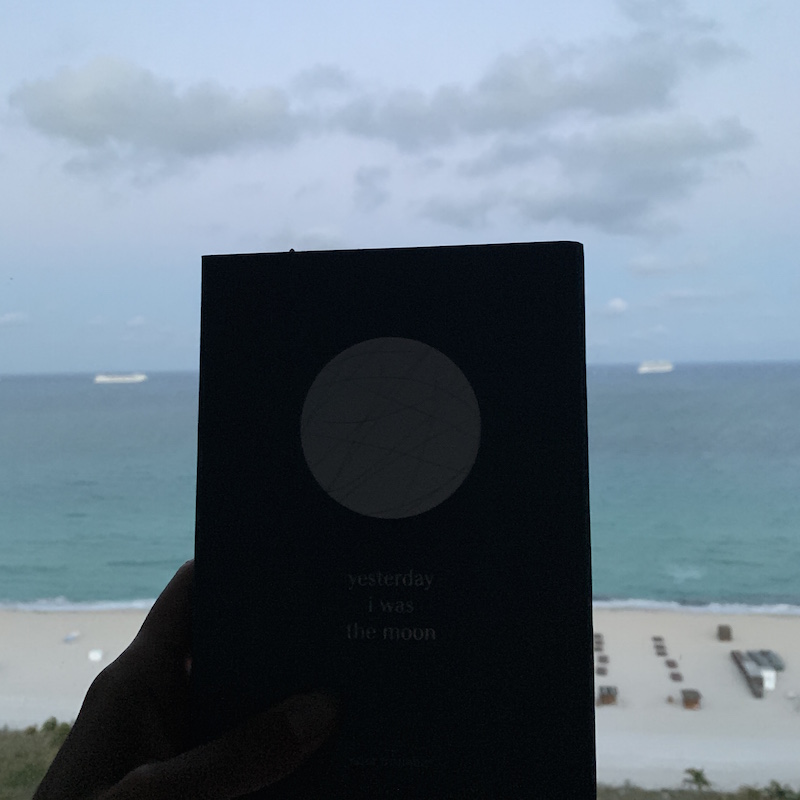Full Moon Alive
A sleepless night during my second full moon quarantined on Miami Beach, stirred this poetic outpour. My bedroom has a panoramic view of the Atlantic ocean (I’m blessed and grateful), which every morning treats me with the only live public spectacle now allowed to me here to see safely – the sunrise. The open sky is too close to the city so I cannot glimpse any stars, save for the largest one to our Earthly eyes — the moon.

That night gusts of open ocean winds flagged my silk nightgown in a coup de force of enthralment. I was standing on the terrace, magnetised by the giant lightbulb of the moon glaring full or in some gasp of the changing moment, partly shaded by the fast paced clouds. In that moment I knew I would not sleep easily if I do not chanel some of that energy speaking to me in its commanding voice.
Reading for hours, midnight approaching. I was still afflush with vitality, and I was glad that the usual cradle of the book did not tame my sprinting mind. Lifting my gaze up to the moon, the whispering potency of the night, suddenly, I had to grab paper and pen. On my night table, aside other piled up literature, set face up a small collection of brief poems by the female Pakistani artist Noor Unnahar. Its moon-gray cover titled YESTERDAY I WAS THE MOON nodded to the occasion. It was not about the moon light though.




Now I am the morning
Yesterday I was the moon
Sleepless
My soul glaring
A fool
I did not know who I was
Back then, but now I know
><
A reflection is not a unique creation
Never say “but”, she said
The past is over, yet
Deep down I knew that
Strength
was a posture covering doubts
Eloquence
overshadowed innate sensuality
Speed
floundered calm mind
Carelessness
veiled a deep concern
Still, I surprise myself — will I?
Some day get to know
Who I am
Despite these flops of mind
Being alive, sensing
Perhaps I shall
Dwell
In a faraway cave
To be pure me
Not a doll
To be played with
But longing to fully be
Yesterday I was the moon
— But now I am the morning
~ Joy


Whatever happened in the past, yesterday does not define who you are today. It only says what you decided, experienced, felt. The past mistakes are not finite dead holes. Deep down, if you connect with yourself is the true you — in the past, present and future — become love. This authentic you can resolve to come back to the purest self, unhinged yet still kind, the balancing scale of inter-human co-existence.
I thought, as most of us did when I was in my late teens, early 20s even, that I totally expressed who I am, independent, unconventional, but I did not know in spite of my authenticity. There are so many layers to peel off, I wrote a poem on this in my late 30s (will certainly publish it in my adventuresome memoir one day).
I learned that I can only glimpse into my own self when I totally shut down emotions as in a deep meditation, when totally giving myself to nature, or when I allow them out off my chest. The wild beasts bursting into the open space are tamed by being let free from the inner cage I put them into. By recognising that these emotions are just a human part of me that passes soon, I feel more alive! And, the full moon reminded me.

This poem by Noor Unnahar resonates:
do not worry
about people
they’re wearing the same flesh
breathing the same chemicals
walking on the same solid earth
as you
so why should it matter
when
you are them and they are you
This empowers me, gives me courage to go forward without being burdened by others’ opinions. I purely am and create what I love. While I hope it connects, inspires and elevates others, I am not attached to my writing work. I hope you are empowered or more connected through our liberal female voices.
What we are other than one human race. We are animals profiting from the bounty of this Earth co-existing with plants in a reciprocal ecosystem conditioned by natural laws we cannot easily change. If you want to get more, you’ll have to give more. This is sustainability, but that goes far beyond the above poems, and I address this need for mutual thriving elsewhere here on La Muse Blue.
NOTE: There is no mutual agreement or online support exchange between Noor and myself. I purely chose to highlight her work because I bought her poetry book and like it. I prefer to support other creative people in an organic way. No push, but pure admiration and sharing what I feel we need more of either though collaboration or by recommending their creations.











